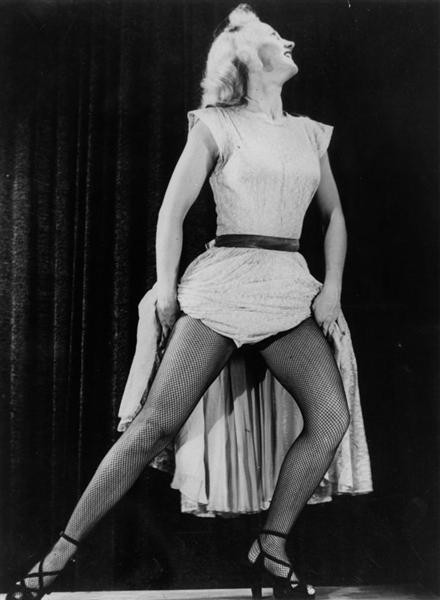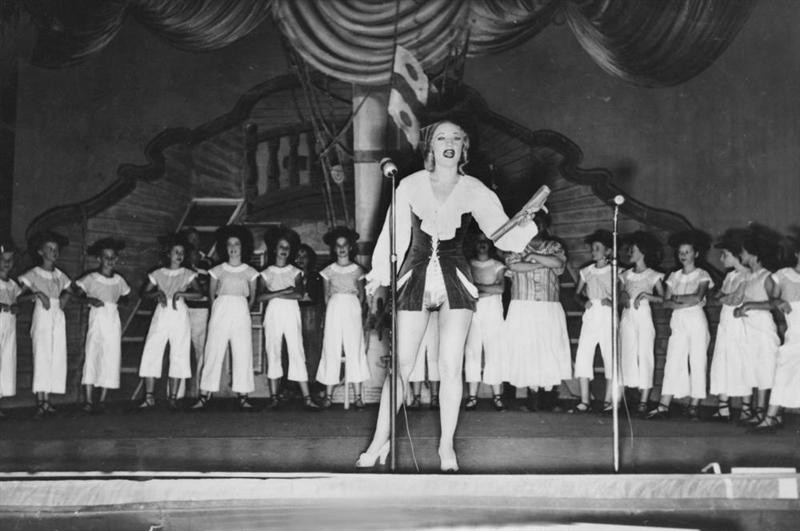A hoofer, a soubrette, and a "nudie cutie": a woman's life in vaudeville
By JOL Admin | 28 April 2011
Peggy Ryan worked hard for a living. She danced, she sang, she took her clothes off when required. She worked onstage and under canvas, she entered competitions, she opened dance schools and directed. She helped out her father, an illusionist and character actor, and she was as versatile as all get out.

And she was not, as one magazine put it rather brutally, A Star.
In a human interest story in People in 1952, 26 year old Peggy was described like this:
“She is not a star; she never could be. Her stocks in trade are a warm, sometimes strident, voice, a pair of nimble feet, a stimulating smile and a figure of considerable merit. Yet without her, and other backstagers like her, entertainment as we know it would collapse overnight. She is the indisputable unit of which a show is made, the foil, the prop, the silk-and-tinsel background against which the star gleams his brightest.”

Vaudeville, burlesque, showgirls, circus performers ,circus animals and even “freakshows” are of increasing interest to both the academic world and historians of popular culture; and in popular culture itself. A fictional version of an 1870s tour of Australia by a troupe of “little people” has just been published, Little People by Jane Sullivan . Internationally, Carol Birch’s Jamrach’s Menagerie and Sarah Gruen’s Water for Elephants take a history of sideshows and elephants and really make them sing - the latter is about to open as a feature film as well. Although these are all historical fiction, historians like Rosemarie Garland-Thomson have made the so-called “freakshow” a site of serious analysis; while historians of popular culture in Australia – like Michelle Arrow, Richard Broome, Richard Waterhouse , Richard White, Jill Julius Matthews use these stories to tell stories about national identity, changing social rituals, working stiffs, performance, and – I’d like to think – the history of blisters and hard work, touting and hopefulness, entertainment and fantasy that goes with it. It’s also about the stories of cities and town, of place, of who goes to see what where – which is why the Dictionary of Sydney tells the story of when the circus and the showgirls, the performers and the tent, came to their town. Oh, and you’d have to say that it’s also – at least some of the time – about the history of sexuality in Australia.
And in the John Oxley Library collection, there are dancers and acrobats, contortionists and soubrettes (a “a female all-rounder in . . . vaudeville theatre”) and ballet dancers, wounded elephants (really, a wounded elephant story – more on that in another post) and the traces of greasepaint and hope, ticket stubs and receipts, permits and flyers that go with it.
Which is how we come to the papers of Peggy Schluter in the John Oxley Library collection. She’s Peggy Ryan in the years I’m reading about. She’s billed as the brunette “soubrette” in some papers, a “Nudie Cutie” in another. A dancer in one; a panto character in another. Because this is one of those joyous, haphazard collections, where playbills for shows she was in are interspersed with those of her father; where professional shots sit next to press clippings; and there’s the odd letter from a serviceman, yearning to look at her, in there as well. And through it all, she’s working. Dealing with sore feet and permits, appeals for work, telegrams about rates of pay and length of performances, reviews and newspaper ads. Balancing on a pedestal wearing nothing but a chiffon scarf in one shot (with a note on the back to say it was for Sydney Truth, Sunday July 4, 1943); legs kicking to the ceiling in another; and a prize awarded for best shoulders at the local cinema in another.
She is, in other words, a hoofer. A chorus girl. The one third from the left.
She began on stage as a child, with parents who also knew how to keep working, and how to reinvent themselves if required. Magician. Illusionist. Character actor. Travelling in company of “Wing Fan Sun: The Marvellous Chinese Conjuror”. Appearing on stage with whoever is hiring.
“Peg comes from a theatrical family, her greasepaint ancestry stretches back to her grandfather . . .” (From a program for a production of “Mother Goose” and “Hello 1949”, presented by Cremorne Productions Pty Ltd and Will Mahoney)
And so the collection combines the public face of this work, and the behind the scenes secrets. There’s a small piece of paper demonstrating the “magic trick” of how to levitate someone off a table. Another series of “glamour” risqué shots show another secret of the studio: legs that are mottled with the cold. A touch of blue, even in black-and-white.
And behind the scenes, it’s also necessary to tout for work, to sell your show, to try to get in with the crème-de-la-crème, the Tivoli circuit. This is what Peggy’s dad, Roland Ryan, was trying to do in 1947 when he explained that he “present a Magic Act of approximately 12 minutes duration.”
"It is well dressed, with excellent apparatus, and eminently suitable for vaudeville presentation. I have had a wide experience, have appeared on Cremorne Theatre under direction of Messrs Mahoney & Geraghty on two occasions and for the past six months have toured Queensland with my own show in Canvas Theatre."
The response, from the Managing Director of the Tivoli Circuit, seems rather dismissive.
“Illusionists generally,” it said, “have never proved satisfactory entertainment here at the Tivoli Theatres.”
As always, with collections like this, it’s easy to be distracted by the side issues, the incidental information. You find yourself wondering about a history of Laundromats (Gates Hygienic Laundry was used by theatrical company J C Williamson, if anyone wants to know) , and the types of cakes that were regular fare in 1946 (“Adams’ famous cream sponges, made in the most hygienic and scientific way known, fully automatic and untouched by hand”). But aren’t we supposed to be talking about vaudeville, performance, comedians and song-and-dance-routines? Well, that’s what collections of papers do so well: combine the everyday with the particular life; the police permits with the glitter. The ads for Laundromats and rat poison in the pages of the playbills and programmes.
And then there’s the everyday matter of taking your clothes off, in the 1940s. Appearing as one of the “nudie cuties” at the Theatre Royal. This, too, seems to be part of Peggy’s everyday working life, although she wasn’t explicit about it by the time of the 1952 profile. But there are many handbills for these shows at the Royal – shows placed in a wider context by theatre historian Jonathan Bollen. There was George Wallace’s “Paris Nudes”, as well as “Atomic Nudes”—a show whose acts include “Robey Buckley, Girl Trumpeter”, “Chung Doo, China’s Gift to Variety”, “Peter Crago, Unusual Boy Contortionist”, and “Peggy Ryan, Vivacious Soubrette”. And then there were other flyers for Vaudeville at the Royal – with titles like, “Evening Nudes”, “French Frolics”, and “Easter Cutie Parade”. The bill for “Blackouts and Blushes” included a performer doing “Stars and Stripes” – so as well as the general war reference, presumably playing to the US servicemen audience.
Peggy had her share of soldierboy followers, and even spent some time on the Sydney Tivoli Circuit that her dad couldn’t quite crack, living in Darlinghurst and treading the streets made familiar by Dymphna Cusack and Florence James’s Come in Spinner. A novel that made stories of sex in the city, desire and work, gender and inequality part of how we understand the forties. One of Peggy's admirers from her days at the Tiv, wrote a letter that – perhaps – shows cheekiness in the guise of coy admiration, and a hard-headed knowledge of the economy of exchange, as he included a ninepenny stamp as well:
“Since I can no longer see you in person, I have to content myself with photos of yourself gleaned from various sources to adorn the walls of my tent and to brighten a rather humdrum life. One has only to live in such camps to realize just how much such attractive photos mean to we boys and so would appreciate it very much if you could forward to me a suitably autographed snapshot to outstrip some of those on display in my pal’s tents and to make me the envy of all the boys.
I hope you will not be offended by my enclosing a ninepenny stamp to cover postage."
You’ll “outstrip” the others indeed, Peggy . . . Was this code for your display? Is that why you kept this letter, out of the many sent to you?
She also performed for the visiting troops, which was both patriotic and virtuous; problematic and unpatriotic, when it came to the US servicemen who famously both thrilled and discomfited the state, the country. In 1944 she was chosen “Favorite Allied Chorus Girl” by the 978th Signal Service Unit in LA – who had been based in Brisbane.
By the 1950s, though, the acceptable story to tell as a vaudeville performer, was that she doesn’t drink or smoke, doesn’t like wild parties, reads Shakespeare, Coward and Keats . . . Of course. (People magazine, as previous) The spectre of the “good woman” rears its head, complicated so very much by being the woman who, “where other girls wear changes of street frocks to work . . . wears a variety of brief tinselled costumes” (from another article in the collection, “Chorines Have Little Time for Night Life”, Courier Mail, 27 March 1946).
And then, within all the stories of performance and choreography, sleight of hand and stagecraft, of stars who have left hardly any trace at all, and those whose influence lingered (she appeared on bills with Roy Rene) . . . there are reminders of working lives, of challenges we can only see through papers like these. Another woman consumed with the practical challenges of being a showgirl, wrote to Peggy in 1952, from WA. She’d read the profile about the young woman who “To audiences . . . is a pair of naked legs that spin through coloured lights and crinkly cellophane showers, a slim, curvaceous cutie among a dozen other slim, curvaceous cuties who work like automatons the full length of the show.” But what Sybil saw, was not just a pair of legs: she saw a pair of stockings, stockings that would survive the rigours of performing. Stockings that were hard to find. So, as a “fellow artist”, Sybil wrote to Peggy:
“I do Cabaret floor shows over here in the West and my problem is that I cannot get a hold of a firm that supplies Fish net stockings suitable for show purposes.
“I read about you in the “People’s” Magazine, and saw a picture of you wearing these type of Stockings (very nice too,) so I thought perhaps if I wrote to you – you might be able to help me. (I am English and have no idea of whom to get in contact with).”
We don’t know Peggy’s response; but we do know she kept the letter.
OM75-102: Peggy Schluter Papers 1920-1955, John Oxley Library, State Library of Queensland.
Kate Evans, John Oxley Library Historian in Residence
Comments
Your email address will not be published.
We welcome relevant, respectful comments.